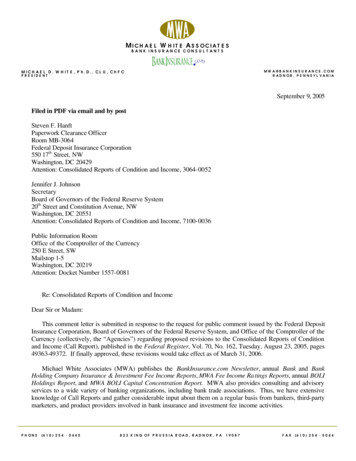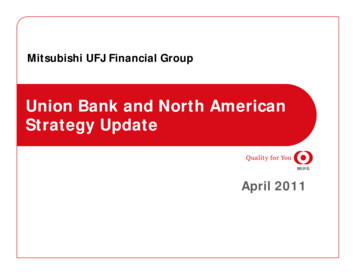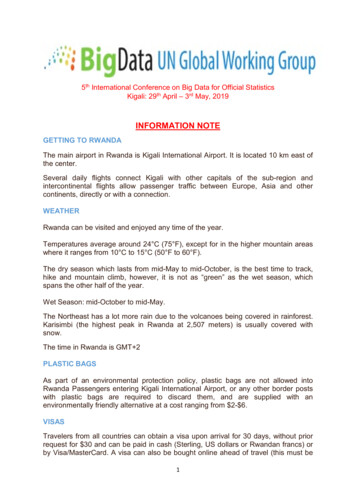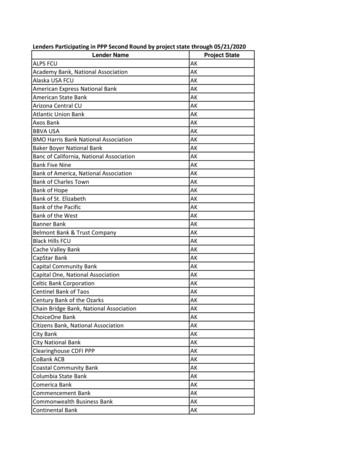
Transcription
MI C H A E L W H I T E A S S O C I A T E SBANK INSURANCE CONSULTANTSMWA@BANKINSURANCE.COMRADNOR, PENNSYLVANIAMICHAEL D. WHITE, Ph.D., CLU, ChFCPRESIDENTSeptember 9, 2005Filed in PDF via email and by postSteven F. HanftPaperwork Clearance OfficerRoom MB-3064Federal Deposit Insurance Corporation550 17th Street, NWWashington, DC 20429Attention: Consolidated Reports of Condition and Income, 3064-0052Jennifer J. JohnsonSecretaryBoard of Governors of the Federal Reserve System20th Street and Constitution Avenue, NWWashington, DC 20551Attention: Consolidated Reports of Condition and Income, 7100-0036Public Information RoomOffice of the Comptroller of the Currency250 E Street, SWMailstop 1-5Washington, DC 20219Attention: Docket Number 1557-0081Re: Consolidated Reports of Condition and IncomeDear Sir or Madam:This comment letter is submitted in response to the request for public comment issued by the Federal DepositInsurance Corporation, Board of Governors of the Federal Reserve System, and Office of the Comptroller of theCurrency (collectively, the “Agencies”) regarding proposed revisions to the Consolidated Reports of Conditionand Income (Call Report), published in the Federal Register, Vol. 70, No. 162, Tuesday, August 23, 2005, pages49363-49372. If finally approved, these revisions would take effect as of March 31, 2006.Michael White Associates (MWA) publishes the BankInsurance.com Newsletter, annual Bank and BankHolding Company Insurance & Investment Fee Income Reports, MWA Fee Income Ra tings Reports, annual BOLIHoldings Report, and MWA BOLI Capital Concentration Report. MWA also provides consulting and advisoryservices to a wide variety of banking organizations, including bank trade associations. Thus, we have extensiveknowledge of Call Reports and gather considerable input about them on a regular basis from bankers, third-partymarketers, and product providers involved in bank insurance and investment fee income activities.PHONE (610) 254 · 0440823 KING OF PRUSSIA ROAD, RADNOR, PA19087FAX (610) 254 · 5044
Proposed Revisions toConsolidate Reports of Condition and IncomeSeptember 9, 2005Page 2In particular, MWA wishes to comment on proposed revisions of three existing items, namely “8. IncomeStatement Reclassification of Income From Annuity Sales,” “9. Investment Banking, Advisory, Brokerage, andUnderwriting Income,” and “11. Life Insurance Assets.” Also, MWA is recommending additional new items toaugment, amplify and enhance the revisions proposed.“8. INCOME STATEMENT RECLASSIFICATION OF INCOME FROM ANNUITY SALES”The first proposed change about which MWA is commenting is the change in the category of noninterestincome in which banks report income from certain sales of annuities – that is, a change from “Income from otherinsurance activities” (Schedule RI, item 5.h.(2)) to “Investment banking, advisory, brokerage, and underwritingfees and commissions” (Schedule RI, item 5.d). This revision of the instructions for item 5.h.(2) and item 5.dmoves the references to annuities in the former item to the latter item.Benefits of this proposed changeThis proposed change is a welcome one. While some banks currently report some commissions and fees fromsales of annuities and related referral and management fees as a component of item 5.h.(2), many banks do notreport revenue from sales of annuities in this item. In fact, they already report commissions and fees from the saleof annuities to bank customers by securities brokerage firms as part of item 5.d. As proposed, it makes sense tofinally treat income from the sale of all annuities not executed in a fiduciary capacity as investment fee incomeand to account for all of it in item 5.d. “Investment banking, advisory, brokerage, and underwriting fees andcommissions.”This proposed revision eliminates confusion over when and where to report annuity fee income. It establishesconsistency and uniformity in reporting, provides greater clarity in instructions to those whose responsibility it isto compile these data from bank departments and subsidiaries, and furthers the goal of error-free Call Reports.Another benefit of relocating annuity commissions and fees from 5.h.(2) to 5.d. is that “Income from otherinsurance activities” in item 5.h.(2) will finally contain only insurance-related income derived from insuranceactivities other than underwriting and reinsurance, such as sales and referrals, not income from what have come tobe deemed financial investment products rather than insurance.MWA recommends an amendment to this proposed change – Split “Income from other insuranceactivities” into “Income from property-casualty insurance activities” and “Income from life -healthinsurance activities”In addition to this very positive, proposed revision to the Call Reports, the Agencies can significantly enhancetheir ability to distinguish, measure and assess risks relating to the distribution of insurance products if theyfurther separate item 5.h.(2) “Income from other insurance activities” into two sub-items, i.e., “Income fromproperty-casualty insurance activities” and “Income from life-health insurance activities.”These two lines of insurance business require different insurance licenses, insure widely different kinds ofrisk, have significantly different compensation structures for agencies and agents, and carry their own businessrelated risks as activities undertaken by banks. Understanding the degree to which an individual bank’s revenueis derived from property-casualty insurance activities versus life-health insurance activities is a first step toevaluating their different risks as activities within a bank. Aggregating this information enables regulators tomeasure the relative dimensions and attendant risks of the contribution the banking industry is making to theproperty-casualty and life-health business segments of the insurance industry. With this knowledge, regulatorscan measure the market share banks are attaining and determine the degree to which the liberalization ofauthorities to conduct nonbank activities under the Gramm-Leach-Bliley Act (GLBA) has paid off.
Proposed Revisions toConsolidate Reports of Condition and IncomeSeptember 9, 2005Page 3Indeed, lots of banks are engaged, to one degree or another, in these “other insurance activities.” At the endof 2004, 3,879 banks or 48 percent (and 1,408 or 63 percent of the largest top-tier bank holding companies)reported some “Income from other insurance activities.” These insurance sales activities have significantlyexpanded as insurance agency acquisitions by banks (and bank holding companies) have approached 500 innumber, following the U.S. Supreme Court’s 1996 decision in the Barnett Banks case and enactment of GLBA inlate 1999. Total insurance income has risen among banks from 2.98 million in 2001 to 4.33 billion in 2004.1(“Income from other insurance activities” among bank holding companies has grown from 4.90 billion in 2001to 9.63 billion in 2004.)Given the size, growth and complexities of the bank insurance business, it behooves the Agencies to separatethe reporting of these quite different forms of insurance income (property-casualty and life-health) so as tomeasure the proportionate share these activities represent within individual banks and aggregately within thebanking industry. Among representatives of the bank insurance industry, this separation of “Income from otherinsurance activities” into “Income from life-health insurance activities” and “Income from property-casualtyinsurance activities” ranks among the most desired, sought-after data for placement in call reports.“9. INVESTMENT BANKING, ADVISORY, BROKERAGE, AND UNDERWRITING INCOME”The second proposed change MWA wishes to address is the splitting of the income statement item for“Investment banking, advisory, brokerage, and underwriting fees and commissions” (Schedule RI, item 5.d) intoseparate items for “Fees and commissions from securities brokerage,” “Fees and commissions from annuitysales,” and “Investment banking, advisory, and underwriting fees and commissions.”Benefits of this proposed changeThis proposed revision, too, should be a welcome change for the 2,304 or 28.5 percent of banks 2 that reported“Investment banking, advisory, brokerage, and underwriting fees and commissions” (Schedule RI, item 5.d) as ofDecember 31, 2004. As the Agencies recognize, the smaller banks that report income in Schedule RI, item 5.d,generally are not involved in investment banking and securities underwriting, but generate fees and commissionsfrom sales to customers of investment products such as annuities, mutual funds or individual securities.It makes sense to include all commissions and fees earned from sales of annuities in 5.d. It also makes senseto better understand the sources of banks’ noninterest income by distinguishing between banks’ investmentbanking (dealer) activities and their sales (brokerage) activitie s by splitting item 5.d – after moving annuity salescommissions and fees and related income into this income statement category from item 5.h.(2) – into threeseparate items.It especially makes sense to split 5.d into “Fees and commissions from securities brokerage” and “Fees andcommissions from annuity sales,” especially since the Agencies are going to continue asking for “Income from1In 2001, bank Call Reports did not segregate “income from other insurance activities” from “underwritingincome from insurance and reinsurance activities.” That segregation first occurred in 2003. So, the figure of 2.98 billion in 2001 represents total insurance revenues, including those from both “other insurance activities”and “insurance and reinsurance activities.” In 2004, banks earned total insurance revenues of 4.33 billion, ofwhich 3.63 billion were “income from other insurance activities” and 0.7 billion were “underwriting incomefrom insurance and reinsurance activities.” Michael White’s Bank Insurance & Investment Fee Income Report,Year-end 2004 edition (Radnor, PA: 2005), p. 13. This report is based on bank Call Report data.2Michael White’s Bank Insurance & Investment Fee Income Report, Year-end 2004 edition (Radnor, PA: 2005),p. 68.
Proposed Revisions toConsolidate Reports of Condition and IncomeSeptember 9, 2005Page 4the sale and servicing of mutual funds and annuities” in Schedule RI, Memorandum item 2. “Income from thesale and servicing of mutual funds and annuities” is existing Call Report data that continues to be critic al anduseful to warrant its continued collection from all banks (and bank holding companies). Continued inclusion ofthat data in the Call Report and the proposed separation of fees and commissions from both annuity sales andfrom securities brokerage enable regulators and the public to understand and measure the proportions of incomefrom packaged-product sales (i.e., mutual funds and annuities, separately and together) versus that fromindividual securities. They aid in determining whether a bank has a full-service securities brokerage operation, orjust an annuity-mutual fund sales program, or a mixture, whether it is Series 6 or Series-7 licensed or a hybridprogram – and they help in evaluating the relative types and degrees of risk involved in those sales program.Since most banks do not engage in dealer activities, i.e., investment banking, advisory activities or securitiesunderwriting, it is also a good idea to identify those banks that do. These activities, like others previouslymentioned, carry different kinds of risks and rewards to each institution. Thus, it is appropriate to measure themseparately from retail activities like securities brokerage, mutual fund sales, and annuity sales where the bank isacting as agent.MWA recommends an amendment to this proposed change – Split “Fee and commissions from annuitysales” into three sub-items: (1) “Fees and commissions from fixed annuity sales,” (2) “Fees andcommissions from variable annuity sales,” and (3) “Fees and commissions from equity-indexed annuitysales”This proposed change is good, but it does not go far enough. The Agencies can improve both their proposedrevisions and their subsequent supervision deriving from this information by further splitting “Fees andcommissions from annuity sales” into three sub-items: “Fees and commissions from fixed annuity sales,” “Feesand commissions from variable annuity sales,” and “Fees and commissions from equity-indexed annuity sales.”Variable annuities frequently contribute more revenues to the typical bank broker/dealer than do mutualfunds.3 Often, fixed annuity sales might exceed variable annuity sales. And, sales of equity-indexed annuitieshave been growing faster than any others the last two years. In order to examine a bank’s risk management andinternal controls over its annuity sales practices and assess the types and levels of risk arising from thosepractices,4 it is important and useful to know what types of products represent sources of revenue to a bank and inwhat proportion and significance.5 So, the splitting of annuity revenue into “fixed,” “variable,” and “equity 3Andrew Singer, “A Chill Regulatory Wind Dampens Variable Annuity Sales,” Bank Insurance & SecuritiesMarketing, 2004, BISM Online at http://www.bisanet.org/bism/2004/chill reg.html.4“The insurance sales and annuity line of business should not be run on autopilot, even though this may beconvenient simply because the business line is new and likely unfamiliar to bank management and the board, ismanaged by the ‘business line experts,’ and is already being reviewed by the insurance underwriter and thefunctional regulator. As required in the GLB Act, the Federal Reserve generally does not examine insuranceunderwriters or insurance agencies owned by a bank holding company. Instead, we defer to the appropriate stateinsurance authorities. However, we do review, at the bank or holding company level, the appropriateness of riskmanagement and internal controls over a banking organization's insurance and annuity sales activities, and assessthe level of risk arising from such activities.” Federal Reserve Board Governor Mark W. Olson, “RegulatoryUpdate: Banking Industry, Insurance, and Securities Activitie s,” Remarks at the Bank Insurance and SecuritiesAssociation Legislative, Regulatory, and Compliance Seminar, Washington, DC, June 10, 2004, /2004/20040610/default.htm.5In a press release announcing that an affiliate securities broker-dealer of Citizens Bank will pay a 3 millioncivil fine for unethical and dishonest conduct in pushing the sale of variable annuities, the Secretary of theCommonwealth of Massachusetts took pains to note that “at least half of one financial consultant’s variableannuity sales since January, 2003 had been to elderly clients.” Secretary of the Commonwealth, “Secretary
Proposed Revisions toConsolidate Reports of Condition and IncomeSeptember 9, 2005Page 5indexed” categories makes sense, especially given the recent bad press about, and regulatory scrutiny of, sales ofannuities, particularly variable and equity-indexed annuities. In the bank nondeposit investment product salesarena, knowledge of product-mix or business-mix is an essential ingredient to sound supervision.Variable annuities (VAs)The NASD says that complaints about variable annuity sales practices increased 50 percent from 1999 to2003. 6 Annuities were the product at issue in about 600 arbitration cases in 2004, more than twice the numberfrom three years earlier. Last year, annuities were the third most common security involved in arbitrations,behind stocks and mutual funds. 7 According to the Financial Research Corporation in Boston, 60 percent ofvariable annuity sales came from exchanges in 2003, a substantial increase from the 15 percent of VA sales in1996. 8 As a result, the NASD has not only taken action against a number of companies and brokers, but it hasalso issued several warning letters to investors.9State regulators have also been investigating incidents of abuse in the sale of variable annuities. In the springof 2004, Alabama and Mississippi state regulators fined the investment services subsidiary of AmSouth Bank 225,000 for “failure to adequately protect investors in two states” in cases involving sales of variable annuities.10In February 2005, the Securities Division of the State of Massachusetts issued subpoenas to a dozen banks andbrokers seeking information about their variable annuity sales. The firms included Sovereign Bancorp, CitizensFinancial Group, Century Bancorp Inc., Banknorth Group Inc., Eastern Bank Corp., Medford Co-operative Bank,now owned by Brookline Bancorp Inc., Wachovia Securities, and Infinex Investment Inc., a third-party marketerand brokerage that provides investment product services to approximately 85 community banks and is owned bysome of its bank clients and bank trade associations. 11In July 2005, the Secretary of the Commonwealth of Massachusetts announced, “Bank of America has agreedto offer customers who were 78 or older when they bought variable annuities the opportunity to get out of theannuity penalty free. The agreement applies to Massachusetts’ customers who bought variable annuities in2003 and 2004. Bank of America will extend the offer to customers across the country.”12 “Bank of America’sagreement is poised to have far-reaching implications for variable annuity providers, who have been subject tonumerous lawsuits and regulatory fines.”13Galvin Fines Citizens Bank Affiliate 3 Million for Improper Variable Annuity Sales,” press release, July 22,2005.6Matt Ackermann and Jenna Gottlieb, “NASD Sees Broad Abuses in Annuity Sales,” American Banker, February16, 2005.7Gretchen Morgenson, “Who’s Preying on Your Grandparents?” The New York Times, May 15, 2005.8Andrew Singer, “A Chill Regulatory Wind Dampens Variable Annuity Sales,” Bank Insurance & SecuritiesMarketing, 2004, BISM Online at http://www.bisanet.org/bism/2004/chill reg.html.9Matt Ackermann and Jenna Gottlieb, “NASD Sees Broad Abuses in Annuity Sales,” American Banker, February16, 2005.10Mississippi Secretary of State, “Mississippi, Alabama Regulators Assess 225,000 Fine and Penalties AgainstAmSouth Investment Services,” press release, March 26, 2004.11Andrew Caffrey, “15 firms now face annuities inquiries, Regulators look at ties between insurers, brokers,”Boston Globe, February 18, 200512Secretary of the Commonwealth, “Secretary Galvin Reaches Agreement with Bank of America on VariableAnnuities,” press release, July 13, 2005.13Angela Pruitt, “Bank of Amer, Mass. Agree on Annuities Sales,” Dow Jones Newswires, July 13, 2005. Thisarticle continues: “‘This is earth-shaking news to the variable annuity industry,’ said John Duval, president ofJohn Duval Associates, a securities litigation and consulting firm. He said it could compel other providers torethink the parameters under which some of their annuities were sold.”
Proposed Revisions toConsolidate Reports of Condition and IncomeSeptember 9, 2005Page 6A few days later, the Secretary of the Commonwealth announced that an affiliate securities broker-dealer ofCitizens Bank will pay a 3 million civil fine for unethical and dishonest conduct in pushing the sale of variableannuities to elderly bank customers and failing to maintain internal e-mails. 14VA sales practices clearly have attracted the attention of federal and state securities regulators, consumergroups and the press. Although the Gramm-Leach-Bliley Act mandates functional regulation, the Agencies alsohave a role to play in overseeing these activities. As a part of their risk assessment procedures in examining abank, the Agencies need to know which banks are selling VAs and in what magnitude in order to assess theappropriateness of VA sales practices. “ Some reps believe that VAs will be the next big financialinvestigation.”15 That could subject banks (and bank holding companies) to damaging transaction/operationalrisk, reputation risk, and compliance/legal risk.Equity-indexed annuities (EIAs)Equity-indexed annuities are a complex type of annuity. They offer the potential for variable rates of return,but they are not considered a security. Thus, they are regulated by state insurance commissioners, not the SEC orNASD.16,17An equity-indexed annuity is a type of annuity that grows at the greater of a) an annual, guaranteedminimum rate of return; or b) the return from a specified stock market index (such as the S&P 500),reduced by certain expenses and formulas. At the time the contract is opened, a term is chosen, which isthe number of years that the principal is guaranteed. Technically speaking, equity-indexed annuities are atype of fixed annuity. But an equity-indexed annuity is different than a standard fixed annuity in the waythat earnings are credited to the annuity. For a standard fixed annuity, the issuing insurance companyguarantees a minimum interest rate. The focus is on safety of principal and stable, predictable investmentreturns. With equity-indexed annuities, the contract return is the greater of a) an annual minimum rate, orb) the return of a stock market index (such as the S&P 500), reduced by certain expenses and formulas. Ifthe chosen index rises sufficiently during a specified period, a greater return is credited to the owner’saccount for that period. If the stock market index does not rise sufficiently, or even declines, the lowerminimum rate is credited. The owner is guaranteed to receive back at least all principal (provided ofcourse that the owner has held the contract for the minimum period of time specified in the contract).18Sales of EIAs have been growing rapidly recently. “More than 30% of annuities sold in 2004 were EIAs, amarket share increase of almost 500% since 2002, according to a recent report from Financial Research Corp. andBeacon Research, both of Boston.”19 According to LIMRA International, EIA sales totaled 6.4 billion in thefirst quarter of 2005, up 56 percent from year-earlier levels. Banks sold 300 million worth of EIAs in the firstquarter of 2005, up 79 percent from 168 million in first quarter 2004. EIAs represented 5.4 percent of all fixed14Secretary of the Commonwealth, “Secretary Galvin Fines Citizens Bank Affiliate 3 Million for ImproperVariable Annuity Sales,” press release, July 22, 2005.15Chris O’Leary, “The Trouble with Annuities,” Registered Rep, Sept. 1, 2005, p. 63 and athttp://enews.insurancemail.biz/print.asp?a 1&1nid 307126321.16“Some EIAs are registered with the Securities and Exchange Commission (SEC) as securities. Many are not,based on a determination that they are insurance products that qualify for exemption under the Securities Act of1933.” From NASD, News Release, “NASD Issues Guidance Regarding Equity Indexed Annuity Sales –Concerns About Marketing, Supervision and Investor Protection Cited,” August 8, 2005.17John Waggoner and Kathy Chu, “An annuity with complexities,” USA Today, August 11, 2005, ce/2005-08-11-annuity-info-usat x.htm.18http://www.annuityfyi.com/equity index description.html.19Trevor Thomas, “SEC Contacting Companies on Indexed Annuity Sales Practices,” National Underwriter’sRegistered e-Report, Vol. 4, No. 7, August 2005
Proposed Revisions toConsolidate Reports of Condition and IncomeSeptember 9, 2005Page 7annuity sales in banks during the quarter, up from 4.9 percent in 2004. 20 And, EIAs sold in banks represented 4.7percent of all EIAs sold in the first quarter of this year. Because EIAs combine a minimum guaranteed interestrate with a varia ble rate linked to the performance of the stock market, “they may be replacing VAs [variableannuities] among customers who don’t want to miss out on a market rally,” but fear the potential volatility of thestock market.21“The runaway success of index-linked annuities and their many complexities is [sic] raising some concernsamong regulators.”22 In early August 2005, the Securities and Exchange Commission asked a number ofinsurance companies for information about how they market equity indexed annuity products.23 Despite havingno regulatory authority over EIAs, the NASD issued an Investor Alert entitled “Equity Indexed Annuities – AComplex Choice,” on June 30, 2005.Then, expressing concerns about marketing, supervision, disclosure and investor protection issues, the NASDissued formal guidance to registered firms selling EIAs.24 While NASD asserts that it does not take a position onwhether a particular EIS is a security, NASD says: “Nevertheless, this uncertainty over whether a particularunregistered EIA may be a security complicates a broker-dealer’s supervisory responsibilities.” This, I believe,holds true in the case of a bank, bank holding company, and any affiliated securities brokerage. Given thegrowing concern about EIAs, it seems a wise policy for the Agencies to know if a bank is selling them and, then,to examine the scope and scale of that activity.In light of these concerns and developments, it seems an appropriate time to split “Fees and commissionsfrom annuity sales” into three sub-items: “Fees and commissions from fixed annuity sales,” “Fees andcommissions from variable annuity sales,” and “Fees and commissions from equity-indexed annuity sales.”Banks that sell these products should readily possess the information about earned revenues by product line,because product mix, increases in the sales volumes of a particular product, related compensation, and customersuitability are criteria that are supposed to have been monitored since the release of the Interagency Statement onNondeposit Investment Product Sales Programs in 1994. And, if the Agencies think it is too much to have threecategories of annuity revenues, MWA urges the Agencies, at a bare minimum, to have two categories, i.e., incomefrom fixed annuities (which would include income from EIAs until such time as regulators may redefine EIAs asvariable annuities) and income from variable annuities.“11. LIFE INSURANCE ASSETS”The third and last proposed change to the bank Call Report about which MWA wishes to comment entailsadding an item to Schedule RC-F, “Other Assets” for the carrying value of the bank’s life insurance assets, whichwould replace the item in this schedule for reporting such assets if they exceed 25 percent of “All other assets.”As the Agencies note, the Interagency Statement on the Purchase and Risk Management of Life Insuranceissued in December 2004 provides guidance to help ensure that banks’ risk management processes for bankowned life insurance (BOLI) are consistent with safe and sound banking practices. Therefore, the Agencies are,20“Indexed Annuity Sales Soar in Banks in First Quarter,” NU Online News Service, July 12, 2005.Andrew Singer, “A Chill Regulatory Wind Dampens Variable Annuity Sales,” Bank Insurance & SecuritiesMarketing, 2004, BISM Online at http://www.bisanet.org/bism/2004/chill reg.html.22“A big seller comes under scrutiny,” Life Insurance International, August 31, 2005, page 11, and athttp://enews.insurancemail.biz/print.asp?a 1&1nid 307075937.23Trevor Thomas, “SEC Contacting Companies on Indexed Annuity Sales Practices,” National Underwriter’sRegistered e-Report, Vol. 4, No. 7, August 200524NASD, News Release, “NASD Issues Guidance Regarding Equity Indexed Annuity Sales – Concerns AboutMarketing, Supervision and Investor Protection Cited,” August 8, 2005.21
Proposed Revisions toConsolidate Reports of Condition and IncomeSeptember 9, 2005Page 8correctly, concerned that many banks may not be reporting the aggregate cash surrender value (CSV) of theirBOLI holdings because they do not meet the reporting threshold of being greater than 25,000 and more than 25percent of the banks’ “all other assets.”25 Thus, the Agencies are uncertain as to the total number of banks (orbank holding companies26 ) that hold BOLI assets in the form of life insurance CSV. This lack of reporting isespecially critical since the Agencies advise institutions that it is generally not prudent for an institution’saggregate CSV of BOLI holdings to exceed 25 percent of its capital as measured in accordance with its primaryFederal regulator’s concentration guidelines.27Benefits of this proposed changeOf the 8,089 commercial and FDIC-supervised savings banks operating on December 31, 2004, 41.5 percentdid report holding BOLI assets during the year.28 Of these 3,360 banks that reported having BOLI holdings in theform of life insurance CSV, over 500 had aggregate CSV that exceeded 25 percent of Tier 1 Capital. 29 Over 300banks had aggregate CSV that exceeded the sum of Tier 1 Capital and the Allowance for Loan and Lease Losses.This is known because these banks report their BOLI holdings. What is not known is, among banks that do notreport their BOLI holdings because they do not meet the current reporting threshold, how many and which onesspecifically exceed the guidance of BOLI holdings as 25 percent or less of capital.Eliminating the reporting threshold that BOLI assets exceed 25,000 and 25 percent of its “All other assets”properly requires all banks with BOLI assets to report their aggregate CSV. This way the Agencies can monitorwhether all banks holding life insurance assets are approaching or have exceeded the 25 percent of capitalconcentration threshold.MWA RECOMMENDS THAT THE SAME REVISIONS BE MADE TO THE CONSOLIDATEDFINANCIAL STATEMENTS FOR BANK HOLDING COMPANIES (FORM FR Y-9C)It appears that the proposed revisions published in the Federal Register are not intended to be similarly madeto the Consolidated Financial Statements for Bank Holding Companies (Form FR Y-9C). We certainly hope that25Three in five banks did not report the cash surrender value of their bank-owned life insurance holdings becauseeither they did not own and hold BOLI, or they did not meet the reporting threshold. Currently, according to theFDIC, BOLI holdings in the form of cash surrender value (CSV) a
which 3.63 billion were "income from other insurance activities" and 0.7 billion were "underwriting income from insurance and reinsurance activities." Michael White's Bank Insurance & Investment Fee Income Report, Year-end 2004 edition (Radnor, PA: 2005), p. 13. This report is based on bank Call Report data.










